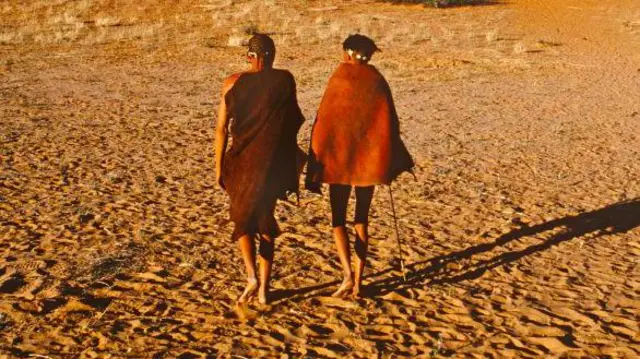A British tourist has been arrested by police in Namibia for alleged s£xual assault of more than 30 indigenous San children at a ‘living museum’.
Douglas Robert Brook, 65, is accused of r@pe, indecently assaulting dozens of children, human trafficking, ‘crimen injuria’, and child exploitation.
Crimen injuria in Namibia refers to the act of ‘unlawfully, intentionally, and seriously impairing the dignity of another’.
Brook was arrested by police on Sunday after allegedly telling San children at the living museum of the Ju’/Hoansi to undress for naked photos and to be touched.
According to Mail Online, the man appeared at Grootfontein Magistrates Court yesterday afternoon to face 38 charges of molesting San children by prosecutor Kristiana Erastus.
He was accused of persuading 33 minors to strip to be photographed and to let him touch their private parts in return for sweets he had taken with him.
His crimes were said to be against the Child Care & Protection Act of 2015 and read with the African Charter and United Nation Convention & Protocols.
It was understood that no plea was taken and Magistrate Abraham Abraham remanded him in custody to come before the court on June 19.
‘The tourist remains in police custody,’ Information Minister Emma Theofelus told the BBC.
The tourist is being held pending his next appearance and it is not yet known if he will be transferred to a main prison.
Namibian police inspector Maureen Mbeha said that he allegedly touched the breasts and buttocks of 16 teenage girls, 14 teenage boys and three minors.
He is said to have entered Namibia on May 15 on holiday and drove to the remote San camp six-hours’ drive from the capital, Windhoek, which he visited.
It is his third annual visit to the same camp where he was known to staff and the manager. He arrived on Saturday and was arrested a day later.
The Namibian Ministry of Environment and Tourism condemned the alleged actions stating they were ‘deeply disrespectful’ to the people of the San.
A spokesman said: ‘The allegations are a serious violation of our law regarding the protection of minors and it is unacceptable for tourists to exploit them.
‘We applaud the Namibia police for their swift actions in attending to this matter and are confident that the law and justice will take place in due course’.
The ‘living museum’ is a joint German-Namibian venture, comprised of seven mock villages set up by the hunter-gatherer communities.
San ‘present the old, almost forgotten culture in traditional dresses in the midst of their reconstructed ‘nomad-village’ from the ancient days,’ the website says.
‘The San of the Living Museum set a high value on presenting the hunter-gatherer culture as [authentically] as possible.’
Visitors can choose from many experiences including a day visit to shooting bows and arrows or dancing round a fire or a 3 day stay with a San family.
The San actors encourage tourists to visit the craft shop to buy traditional art and souvenirs and trade items such as pens or shoes and clothes for goods.
Visitors are warned not to give sweets to children as there are no local dentists. They are instead encouraged to make donations to group who will ensure they receive gifts.
It is understood the actors wear antelope skins to cover themselves, although some adult women still go topless, as was the traditional dress.
The manager of the Ju’/Hoansi museum said that did not apply to teenage girls who would remain fully covered up with leather dress from antelopes.
There are seven ‘living museums’ in Namibia and the group behind them the Living Culture Foundation Namibia was founded by German Dr Ralf Kuhn in 2004.
He remains Chairman of the LCFN which relies heavily on tourist money and donations to ensure the long culture and history of the San is preserved.
The Living Museum Of The Ju’/Hoansi is near the village of Grashoek.
The San are among the oldest surviving civilisations in Southern Africa.
